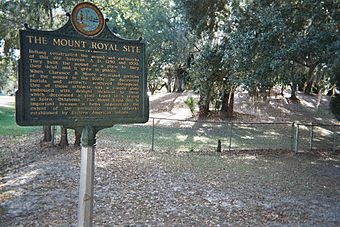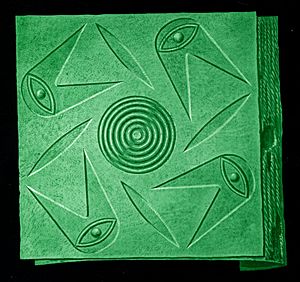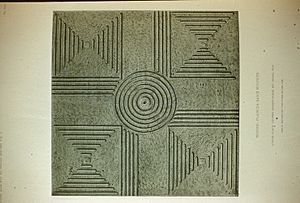Mount Royal (Florida) facts for kids
Quick facts for kids |
|
|
Mount Royal
|
|

Historical marker, with Mount Royal in the background
|
|
| Location | Putnam County, Florida, USA |
|---|---|
| Nearest city | Welaka, Florida |
| Area | < 1-acre (4,000 m2) |
| Built | between 1250 and 1500 A.D. |
| NRHP reference No. | 73000603 |
| Added to NRHP | May 7, 1973 |
Mount Royal (also known as 8PU35) is an important archaeological site in the U.S.. It is found in Putnam County, Florida, near where the St. Johns River flows out of Lake George. The site is about 3 miles (5 km) south of Welaka, Florida. You can find it in the Mount Royal Airpark, right off County Road 309, on the east bank of the St. Johns River.
This special place has a large sand mound and several nearby middens. Middens are ancient trash heaps, often made of shells, that tell us a lot about what people ate and used. People first lived at Mount Royal about 4,000 years ago. The site was mostly empty from 500 BCE until 750 AD.
Mount Royal became active again after 750 AD. After 1050 AD, it grew into the main town of a powerful chiefdom. This chiefdom had connections to the famous Mississippian culture. The town became less important after 1300. However, a settlement called Enacape was still there when Europeans arrived in the 1560s. A Spanish mission named San Antonio de Enacape was located in the town from 1595 until after 1656.
Contents
Where is Mount Royal Located?
The Mount Royal site sits on the east side of the St. Johns River. It is between Lake George to the south and Little Lake George. The site is on the north side of a short part of the river that flows west. (The river generally flows north).
The most noticeable part of the site is a large sand mound. This mound is about 90 meters (295 feet) from the river. There was once a raised path or "avenue" that ran north from the mound to a rectangular pond. This path was still visible in the late 1800s. Today, it is hard to see. The mound itself is on a 1-acre piece of land owned by the State of Florida. The area around it, including the middens and old village, is now part of the Mount Royal Airpark.
Exploring Mount Royal's Past
People have been studying the Mount Royal site for a long time. These studies help us understand the ancient people who lived there.
Early Explorers: The Bartrams
The Mount Royal site was first written about in 1766. This was when John Bartram and his son William visited it. William came back to the site 15 years later. They found a sand mound that was about 90 meters (100 yards) across. It was also nearly 6 meters (20 feet) tall.
The Bartrams described a wide "avenue" running north from the mound. This path had raised banks on its sides. It was "level as a floor," about 55 meters (60 yards) wide. The avenue stretched for about 1.2 kilometers (0.75 miles) to a rectangular pond. This pond was 90 meters (100 yards) wide and 137 meters (150 yards) long. John Bartram thought the pond might have been a borrow pit. This means it was a hole where sand was dug out to build the mound.
When William returned, he saw that an orange grove and trees that had lined the avenue were gone. They had been cleared for planting. A 19th-century archaeologist named Samuel Haven said the Bartrams' reports were the first "careful and intelligent" descriptions of a Native American mound.
Clarence Moore's Discoveries
In 1891, Clarence Bloomfield Moore, an archaeologist who taught himself, explored shell middens along the St. Johns River. He returned in 1893 to dig into sand mounds, including the one at Mount Royal. In just two short periods (two-and-a-half weeks in 1893 and three weeks in 1894), Moore dug up and then refilled almost the entire sand mound. He shared what he found in two detailed reports in 1894.
Before Moore's first visit, the mound had been plowed. This caused its sides to slump, making the ground around it higher. Moore had trouble measuring the mound's exact height. He estimated it was 4.9 meters (16 feet) high. He believed it had been much taller originally. He also reported that the mound was 168 meters (551 feet) around. The connection between the avenue and the mound was no longer clear. He noted the avenue was 11 to 18 meters (12 to 20 yards) wide. It had raised banks (berms) that were about 0.76 meters (2.5 feet) high and 3.7 meters (12 feet) wide.
Modern Investigations
In the early 1950s, John Mann Goggin and his students from the University of Florida collected pottery pieces and other items. They found these on the surface of the middens and other areas near the Mount Royal mound. By this time, the avenue that the Bartrams and Moore described was not visible from the ground. However, it could still be seen in aerial photographs.
Because the area was planned for homes, B. Calvin Jones from the Florida Bureau of Archaeological Research led new investigations. These happened in 1983, 1994, and 1995. His work included shovel tests (small holes dug to find artifacts) and careful digs in specific spots.
The Mount Royal Mound
Clarence Moore found charcoal mixed with sand at the bottom of the mound. He thought that fire might have been used in special ceremonies when mound building began. The mound was mostly built with yellow sand from the local area. However, some layers of sand were colored with hematite, a red mineral.
Artifacts were more often found in these red-tinted sand layers. The entire mound was topped with a layer of hematite-colored sand. This layer was up to 2.1 meters (7 feet) deep in some parts. Moore described the color of this sand as "crushed strawberry," "brick red," or "Indian red."
Most of the artifacts were found in the top 2.1 meters (7 feet) of the mound. A few items were at the very bottom. However, the middle part of the mound, from 0.3 to 2.7 meters (1 to 9 feet) above the ground, had almost no artifacts. Burials were found throughout the mound. Sadly, the skeletons were always badly decayed, often with only teeth remaining.
Early Life at Mount Royal
The first people to live at Mount Royal arrived around 2000 BCE. They were part of the Orange period culture. These people were hunter-gatherers. They caught shellfish and fish from the rivers and coastal waters of northeastern Florida. They also gathered wild plants and hunted animals. The Orange period began when pottery first appeared in this part of Florida. This was shortly after pottery was seen in coastal Georgia and South Carolina, making it some of the earliest in North America.
Around 500 BCE, the Orange period changed into the St. Johns culture. During the first part of the St. Johns Culture (called St. Johns I), many sites along the St. Johns River were lived in. However, there is no sign that Mount Royal was occupied during this time.
Around 750 AD, as St. Johns I changed into St. Johns II, people returned to Mount Royal. Moore noticed that St. Johns Check Stamped pottery, which is typical of the St. Johns II period, was present from the very start of the Mount Royal mound's construction. While St. Johns people probably already grew squashes and other plants in gardens, the growing of maize (corn) likely started early in the St. Johns II period.
Powerful Leaders and Centers
After about 1050 AD, chiefdoms began to form among the St. Johns culture people. A chief from a larger village would gain power over smaller villages nearby. Some very powerful chiefs would even create alliances with other chiefdoms. The strongest chiefdoms, which held both political and religious power, became important ceremonial centers. They showed their status by building large mounds.
Mount Royal was one such ceremonial center for hundreds of years. It might have been the largest one in a wide area along the St. Johns River.
On May 7, 1973, Mount Royal was added to the U.S. National Register of Historic Places. This means it is recognized as a very important historical site.





